Glaciers, Lagoons, Car Races, DUI Checkpoints, and Meat on a Plate: Travel tips to help you make the most of your visit to El Calafate – the gateway to glaciers.
As the plane began its descent into El Calafate, the first thing that came to mind as I looked out the window was … this looks a lot like New Mexico! Well, New Mexico with a lot more water. I immediately had a good feeling about the place. Granted, that thought could’ve been clouded by the fact that I was now 25 hours into my journey from home in New Mexico via Houston, Buenos Aires international airport, taxi to the Buenos Aires domestic airport, and finally, El Calafate. At that point, it would feel good to be nearly anywhere but on a plane.
Much to the relief of our legs, my brother and I exited the plane and were excited to begin ten days of exploring Patagonia. This first post will focus on one of the major hubs for exploring the southern Patagonia region of Argentina: El Calafate. Here are some travel tips to help you make the most of your visit to this gateway to glaciers.

And, as the plane turned, I suddenly saw this …

Table of Contents
A Brief Overview of El Calafate
Founded in 1927, El Calafate is a small city of ~8,000 residents in the southern part of Argentina’s Patagonia region. The area was originally populated by wool traders. Then, in 1937, Perito Moreno National Park was established by the government of Argentina. This triggered the creation of roads to access the Park and help spur the growth of the town. Today, El Calafate serves as a popular hub for exploring the spectacular glaciers and mountains in the region.

El Calafate gets its name from an evergreen, thorny shrub (Berberis buxifolia) known as calafate in Spanish. This shrub produces yellow flowers and a tasty berry that’s used for many desserts in southern Patagonia. The El Calafate tourism site warns that, according to one traditional story, “whoever eats calafate will return for more.” I enjoyed a calafate mousse dessert one evening and have to admit that is was tasty, and not too sweet. Not that I have a problem with too sweet.

El Calafate is easy to navigate, although you’ll likely want to rent a car if you plan to explore the surrounding area. The city center is located about 30 minutes from the El Calafate airport. If you’re renting a car from the airport, you’ll want to be completely sober, as you’ll be passing through a mandatory police checkpoint on your way into town. Getting busted with a DUI is probably not the way you’d like to start your trip. The police were giving breathalyzers to drivers of most of the cars that I saw, including for me. Given that my most recent drink was about 12 years ago, I wasn’t too worried.


Things to do in El Calafate
Stroll along Av. del Libertador and visit the Artisan Market
You’ll no doubt spend time wandering up and down the main street (Av. del Libertador) of El Calafate, perhaps visiting the busy supermarket (La Anónima), shops, artisan market, and local restaurants. At least that’s what we did soon after arriving. The supermarket was handy for stocking up on water and snacks for hiking. We weren’t the only ones with that idea. It was a busy supermarket each time we visited.



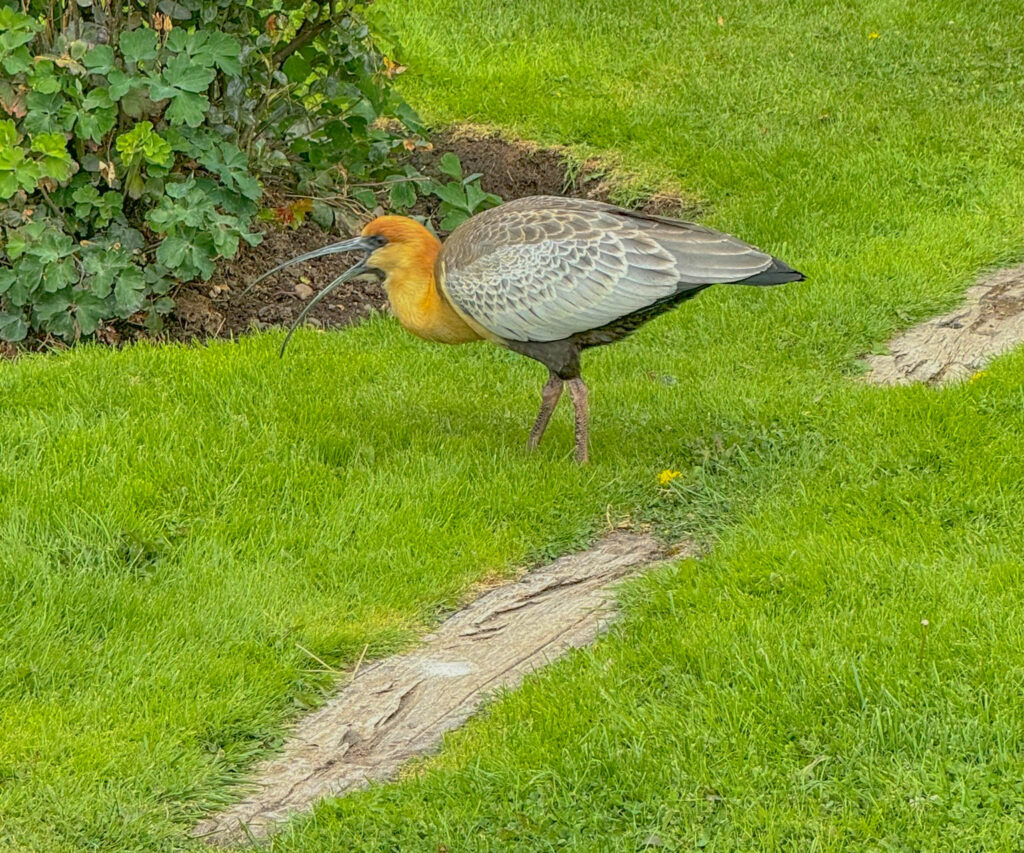

Meat on a Plate
Argentina is world-famous for steak so, assuming you eat meat, this is a no brainer. While you won’t necessarily find famous, world-class steak houses like the ones you’ll find in Buenos Aires, we enjoyed several top notch meals that included excellent cuts of meat.
We typically started our meals with empanadas, a pastry turnover that’s filled with beef. At one of our fancier meals, the empanadas were filled with wagyu beef, but I couldn’t really tell the difference with some of the other empanadas that I had. All of the empanadas were tasty.

Not surprisingly, our main course nearly always consisted of some kind of meat, and a lot of it. Many restaurants offer meat plates that provide you with a taste of different cuts of beef, chicken, and pork. One restaurant we visited had guanaco (closely related to llama) on the menu, so I decided to give it a try. Of all the different meat dishes I tried in Argentina, I generally preferred the tenderloin – a bit pricier but well worth it in my opinion.
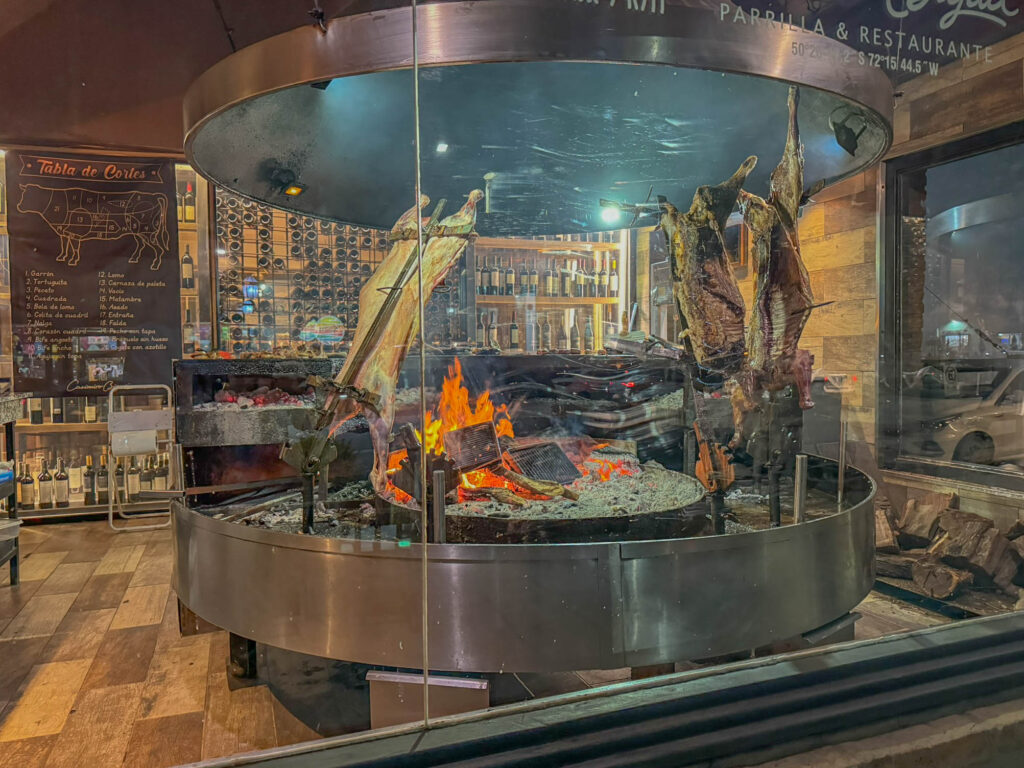


Our visit to El Calafate also included our first taste of blood sausage and experiencing its unsettling texture. I had a feeling that eating cooked blood that’s mixed with a filler and packaged in a sausage casing would not be a winner for me. I was right. That will be my first and last taste of blood sausage.
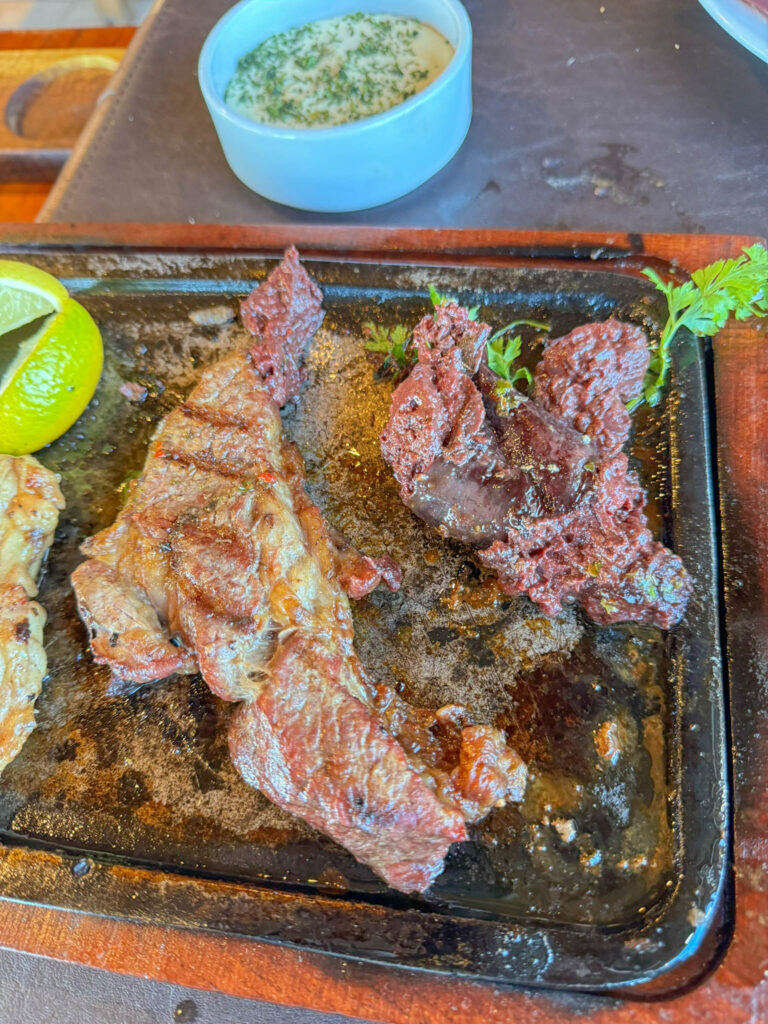
To undo that image, let’s move on to dessert. To end the meal, I usually opted for dulce de leche crepes, many of which were excellent. The best ones were served warm, filled with caramel, topped with powdered sugar, and served with dulce de leche ice cream. They were sweet desserts, but a very tasty way to end the meal. Especially after tasting blood sausage. After eating so many desserts, you won’t be surprised to learn that I gained 5 lbs. on this trip. But it was worth it!

As for beer, the Patagonia region has a variety of craft beer to enjoy. One popular brewery, with locations throughout Argentina, is called Patagonia Brewing. I’ll write more about Patagonia craft beer in a future post about Bariloche, Argentina.


Perito Moreno Glacier / Parque Nacional Los Glaciares
Another obvious activity in the glacier capital of Argentina is to … drum roll please … visit a glacier. The best place to see the glaciers is Parque Nacional Los Glaciares (aka Los Glaciares National Park or Glaciers National Park), home to 48 major glaciers and about 190 smaller glaciers. Parque Nacional Los Glaciares is about a 90-minute drive from El Calafate.

Roughly 40% of the park is covered by giant ice fields, with some of them flowing into two big lakes, including Argentino Lake. It makes for a spectacular setting. As a bonus, we got to hear the impressive sound of large chunks of ice calving off the glacier AND we saw two Andean condors flying high above the mountains.
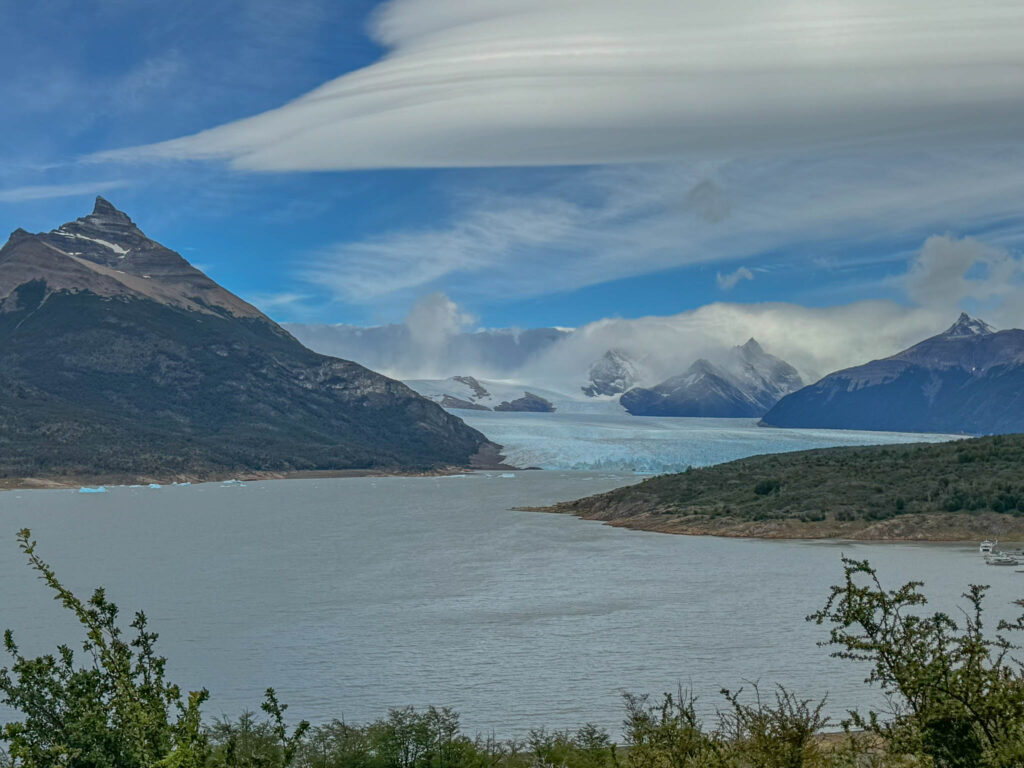
The entrance fee to the National Park was 12,000 pesos (about $12 each at the time of our visit), and we had the option to pay by credit card. The only part that we didn’t like is discovering that we were required to get a on a bus if we wanted to go to the main glacier overlook area. Feeling antisocial, we opted out of that option and took photos from other scenic overlook areas instead.
Towards the end of the road to the glaciers, you’ll find several tour operators that offer half-day and full-day tours / boat trips to the glaciers during high season. Some of the longer trips include strapping on crampons and walking on a glacier. There are also opportunities to hike, mountain bike, or go horseback riding in the area.




Birdwatching at Laguna Nimez Reserve
If you’re into birding, then it’s a no brainer that you should visit Laguna Nimez Reserve in El Calafate. Even if you’re not into birds, it’s still worth walking around the Reserve. Walking the trail gives you a different perspective of the local landscape with its variety of habitats, along with some nice views of the mountains in the distance.
The easy, flat, out-and-back trail is about 3 miles total, which takes about 2 hours since you’ll be stopping often to look at birds, plants, and scenery. There are many interpretive signs along the trail, which include pictures of the common bird species you can expect to see. The easy walking trail at Laguna Nimez Reserve proved to be a perfect activity for our very sore legs, since it was the day after we did a strenuous hike in Chile.

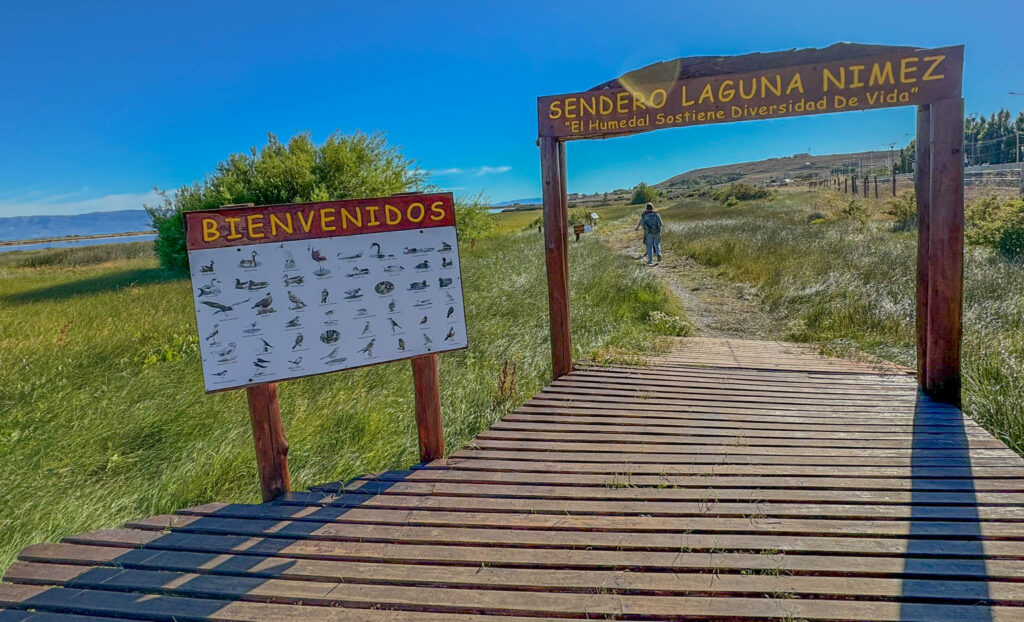
I ended up seeing 21 species during our 3-mile walk, most of which I’ve never heard of before. Needless to say, it took some time for me to confirm the identification of many of these birds. I used a combination of trail signs, Merlin sound ID, and two very mediocre bird apps to help me confirm the identifications.
For my fellow bird nerds, here’s what I saw during our walk:
- Crested Duck
- Red Shoveler
- Chiloe Wigeon
- Yellow-billed Pintail
- Andean Duck
- Chilean Flamingo
- Red-gartered Coot
- White-winged Coot
- Southern Lapwing
- Magellanic Snipe
- Kelp Gull
- Cinereous Harrier
- Chimango Caracara
- Wren-like Rushbird
- Buff-winged Cinclodes
- Austral Canastero
- Blue-and-white Swallow
- Grass Wren
- House Sparrow
- Rufous-collared Sparrow
- Long-tailed Meadowlark

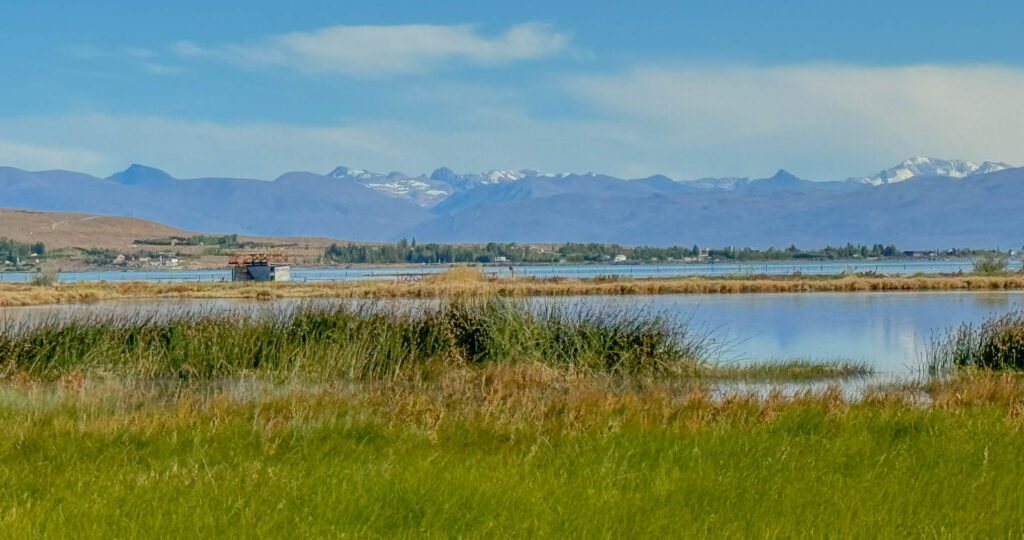
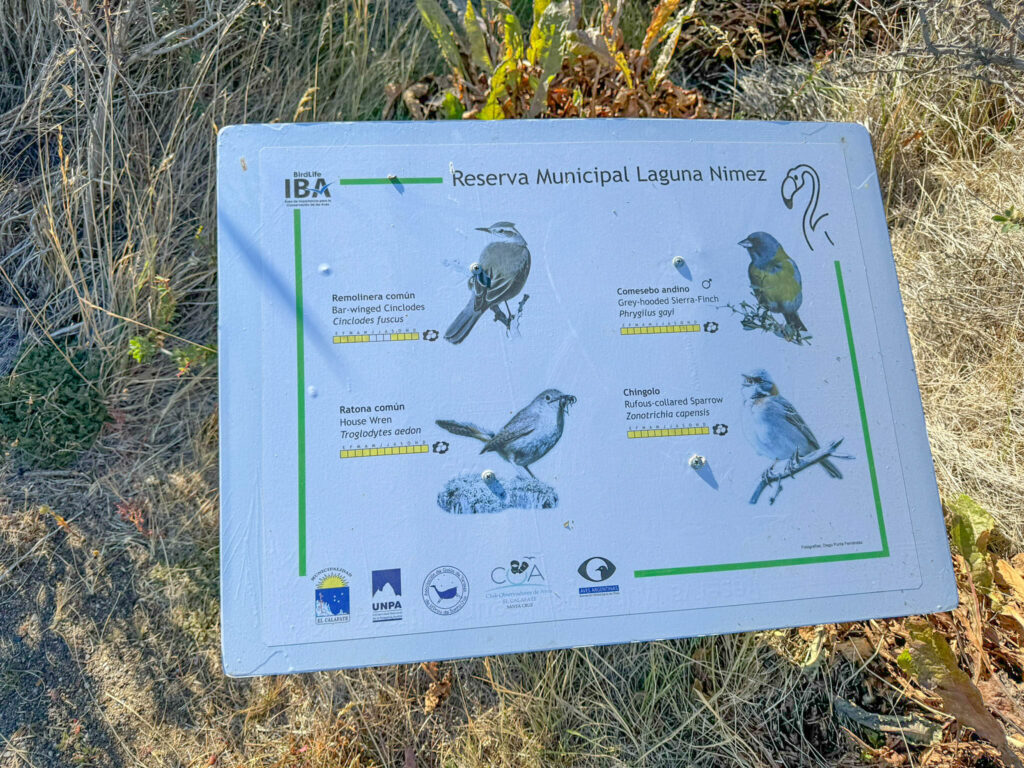


If birding is not your thing, and walking on trails is not of interest, you can always pose for a corny photo outside of the visitor center. Which, of course, I did.

A day at the races: Auto racing at El Calafate’s Autódromo Enrique Freile
For motorsport enthusiasts, you may also be able to experience car racing at the Autódromo Enrique Freile rack track located ~6 miles outside of the city center of El Calafate. Autódromo Enrique Freile is a 3.8km (2.361 mile) circuit, with 15 turns, that opened in April 2023. In 2024, the track hosted the opening round of the Turismo Carretera, which happened to take place during our visit to El Calafate. The event included 43 competitors, with three ‘heats’ of 19 kilometers, and a ‘final’ of 95 kilometers.


Even if you don’t plan to attend an auto race at the track, a race could impact your trip in several ways. For example, during our birdwatching visit to the Laguna Nimez Reserve, we could hear the buzz of the race cars throughout our visit. Also, the traffic to and from the race can result in a long line of traffic at the police DUI checkpoint. On our return drive from Torres del Paine (Chile) to El Calafate, we were stuck in standstill traffic for about 30 minutes as a result. Plan accordingly if you are driving to or from the airport on a race day.
Burn off a few calories at the gym
With all the good food you’ll be eating, you might feel the urge to find a gym to burn off some calories. I usually make a point of visiting gyms during all of my trips as I think it’s fun to see the local gym culture in the places I visit. Plus, I enjoy working out. So, after my fourth serving of dulce de leche crepes in 3 days, I decided it was time for a workout.
After doing some research, I settled on Ouro Gym, tucked away on a dirt road a mile or two from the city center. The facility was clean, had all the equipment I was looking for, and I enjoyed my workout there. The main difference I noticed from the typical gyms I visit was the music. The gym’s TV and speakers played (at loud volume) a video of a concert from a popular Argentine band called La K’onga, which had a high-energy salsa vibe to it. The entrance fee for a gym day pass was 4000 pesos ($4) when I visited. I initially handed over a US$5 bill, but the man said, “no cambio”. So I handed over US $3 in singles and 800 pesos (all I had) and he waived me in.



Figure out how to get large souvenirs back home
Ok, this one is not necessarily a recommended activity, but it was one that I faced on my last day in El Calafate. During my visit to the Artisan market, one stall was operated by young woman (perhaps in her late teens) who was selling her art. One of the items she had on display was an Andean Condor. I asked how much the Andean Condor picture cost and she responded with 22000 pesos (US$ 22). It wasn’t exactly fine art, but that seemed like a very reasonable price for a unique souvenir, so I decided to support her entrepreneurial endeavors and bought it by handing her a US $20 bill and two $1000 peso notes.
That purchase decision introduced a new dilemma. How the in the hell will I get this Andean condor picture home? My brother and I thought it would be a fun challenge. My Plan A was to ship it. Plan B was to attempt to bring it on the plane. If those two options failed, then my Plan C was to donate it to a local kid who might enjoy it.

For Plan A, I visited an upscale store and asked how they ship large items abroad. The short answer was, they don’t. They directed me to a Western Union across the street. So, I crossed the street and found a very long line of people. Pressed for time, I immediately decided to scratch Plan A off my list.
As I walked along the main street, I was starting to lean towards Plan C, but then I stumbled across a small shop that appeared to sell some arts and crafts materials. In one aisle, I spotted two flat pieces of very thin cardboard that were intended to be folded up into boxes. I didn’t see anything else in the store that would work, so I grabbed the two boxes. Next, I spotted some mailing tape behind the counter. But first, I needed to figure out how to ask for it in Spanish. I pulled up google translate while I waited in what I thought was a line, before realizing that I first needed to take a number. So, I walked to the ticket dispenser, took a number, and waited around for a few more minutes before my number was called. Lucky 13.

I stepped up to the woman behind the counter and tried a google translation for mailing tape (cinta de correo), but that translation didn’t work out so well. After searching the aisles, she came with adhesive stickers. Next, I tried the google translation for adhesive tape (cinta adhesiva) while pretending to put tape around the boxes I was holding. It worked. She laughed and brought me exactly what I needed. I gave her $5 in exchange for the roll of tape and the two cardboard boxes, and returned to my rental car to see if this approach might work. It wasn’t pretty, but it looked promising.

To make a long story short, during the journey home, I was able to bring it as a carry-on and it fit in the overhead compartment for 3 of my 4 remaining flights. For the very last flight (a small plane from Houston to Albuquerque), it was too big for the overhead compartment, so I was sweating it a bit. I was in the window seat, so I ended up slipping the picture between the side of the seat and the wall of the plane, put my jacket over it, and hoped nobody would notice. In the end, it worked! I was able to get it home in one piece and it’s a fun memory of the trip.
In Closing
El Calafate is a good place to visit if you’re planning to be in southern Patagonia. It serves great hub for visiting the glaciers of Parque National del Glaciares (90-minute drive), the mountains (such as Fitz Roy) of El Chalten (2.5 hour drive), and even Torres del Paine National Park in Chile (3.5 – 4.5 hour drive).
In my next post, I’ll share information about the drive to and from El Calafate to Torres del Paine National Park (Chile). After that, I’ll create another post to share my experience hiking to the Torres del Paine Viewpoint via the Las Torres a Chileno Trail, considered to be one of the most famous hikes in the world.


Thought for the Week
This week’s thought for the week is in the form of a poem called “You Learn” from Argentine poet, essayist, and short story writer, Jorge Luis Borges (24 August 1899 – 14 June 1986).
After a while you learn the subtle difference
Between holding a hand and chaining a soul,
And you learn that love doesn’t mean leaning
And company doesn’t mean security.
And you begin to learn that kisses aren’t contracts
And presents aren’t promises,
And you begin to accept your defeats
With your head up and your eyes open
With the grace of a woman, not the grief of a child,
And you learn to build all your roads on today
Because tomorrow’s ground is too uncertain for plans
And futures have a way of falling down in mid-flight.
After a while you learn…
That even sunshine burns if you get too much.
So you plant your garden and decorate your own soul,
Instead of waiting for someone to bring you flowers.
And you learn that you really can endure…
That you really are strong
And you really do have worth…
And you learn and learn…
With every good-bye you learn.
Thanks for reading and happy travels!
Mark (The New Mexico Travel Guy)

Mark Aspelin, The New Mexico Travel Guy (www.newmexicotravelguy.com), is a travel writer and author of two books who has enjoyed a wide variety of adventures in his travels to over 100 countries and all 50 U.S. States. His current project involves visiting EVERY town in his home state of New Mexico (there’s over 500 towns) and writing a story about each one. He’s on track to finish the project by his early-mid 100s. When not traveling, Mark lives as a recluse in the mountains outside of Albuquerque, New Mexico.



